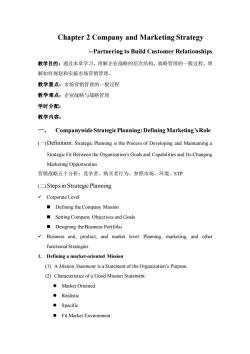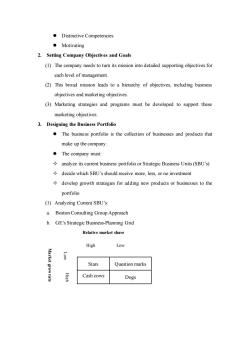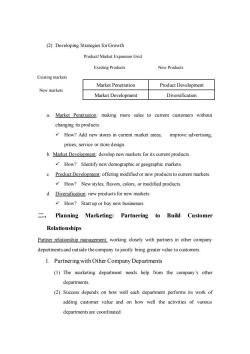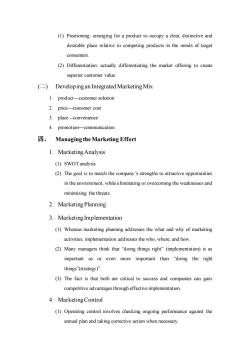《市场营销学》课程授课教案(双语)Chapter 2 Company and Marketing Strategy

Chapter 2 Company and Marketing Strategy -Partnering to Build Customer Relationships 教学目的:通过本章学习,理解企业战略的层次结构,战略管理的一般过程,理 解如何规划和实施市场营销管理。 教学重点:市场营销管理的一般过程 教学难点:企业战略与战略管理 学时分配: 教学内容: Companywide Strategic Planning:Defining Marketing's Role ()Definition:Strategic Planning is the Process of Developing and Maintaining a Strategic Fit Between the Organization's Goals and Capabilities and Its Changing Marketing Opportunities. 营销战略五个分析:竞争者、购买者行为、参照市场、环境、STP ()Steps in Strategic Planning √Corporate Level Defining the Company Mission Setting Company Objectives and Goals Designing the Business Portfolio Business unit,product,and market level:Planning.marketing.and other functional Strategies 1.Defining a market-oriented Mission (1)A Mission Statement is a Statement of the Organization's Purpose (2)Characteristics ofa Good Mission Statement: ●Market Oriented ●Realistic ·Specific Fit Market Environment
Chapter 2 Company and Marketing Strategy -Partnering to Build Customer Relationships 教学目的:通过本章学习,理解企业战略的层次结构,战略管理的一般过程,理 解如何规划和实施市场营销管理。 教学重点:市场营销管理的一般过程 教学难点:企业战略与战略管理 学时分配: 教学内容: 一、 Companywide Strategic Planning: Defining Marketing’s Role (一)Definition: Strategic Planning is the Process of Developing and Maintaining a Strategic Fit Between the Organization’s Goals and Capabilities and Its Changing Marketing Opportunities. 营销战略五个分析:竞争者、购买者行为、参照市场、环境、STP (二) Steps in Strategic Planning ✓ Corporate Level ◼ Defining the Company Mission ◼ Setting Company Objectives and Goals ◼ Designing the Business Portfolio ✓ Business unit, product, and market level: Planning, marketing, and other functional Strategies 1. Defining a market-oriented Mission (1) A Mission Statement is a Statement of the Organization’s Purpose. (2) Characteristics of a Good Mission Statement: ⚫ Market Oriented ⚫ Realistic ⚫ Specific ⚫ Fit Market Environment

Distinctive Competencies ●Motivating 2.Setting Company Objectives and Goals (1)The company needs to turn its mission into detailed supporting objectives for each level of management. (2)This broad mission leads to a hierarchy of objectives,including business objectives and marketing objectives (3)Marketing strategies and programs must be developed to support these marketing objectives. 3.Designing the Business Portfolio The business portfolio is the collection of businesses and products that make up the company. ●The company must: analyze its curent business portfolio or Strategic Business Units(SBU's) decide which SBU's should receive more,less,or no investment develop growth strategies for adding new products or businesses to the portfolio (1)Analyzing Current SBU's a.Boston Consulting Group Approach b.GE's Strategic Business-Planning Grid Relative market share High Low Stars Question marks Cash cows Dogs
⚫ Distinctive Competencies ⚫ Motivating 2. Setting Company Objectives and Goals (1) The company needs to turn its mission into detailed supporting objectives for each level of management. (2) This broad mission leads to a hierarchy of objectives, including business objectives and marketing objectives. (3) Marketing strategies and programs must be developed to support these marketing objectives. 3. Designing the Business Portfolio ⚫ The business portfolio is the collection of businesses and products that make up the company. ⚫ The company must: analyze its current business portfolio or Strategic Business Units (SBU’s) decide which SBU’s should receive more, less, or no investment develop growth strategies for adding new products or businesses to the portfolio (1) Analyzing Current SBU’s: a. Boston Consulting Group Approach b. GE’s Strategic Business-Planning Grid Stars Question marks Cash cows Dogs High Low High Low Market grow rate Relative market share

(2)Developing Strategies for Growth Product/Market Expansion Grid Existing Products New Products Existing markets Market Penetration Product Development New markets Market Development Diversification a.Market Penetration: making more sales to current customers without changing its products How?Add new stores in current market areas.improve advertising. prices,service or store design. b.Market Development:develop new markets for its current products How?Identify new demographic or geographic markets. c.Product Development:offering modified or new products to current markets. How?New styles,flavors,colors,or modified products. d.Diversification:new products for new markets How?Start up or buy new businesses. Planning Marketing:Partnering to Build Customer Relationships Partner relationship management working closely with partners in other company departments and outside the company tojointly bring greater value to customers. 1.Partnering with Other Company Departments (1)The marketing department needs help from the company's other departments. (2)Success depends on how well each department performs its work of adding customer value and on how well the activities of various departments are coordinated
(2) Developing Strategies for Growth Market Penetration Product Development Market Development Diversification a. Market Penetration: making more sales to current customers without changing its products. ✓ How? Add new stores in current market areas, improve advertising, prices, service or store design. b. Market Development: develop new markets for its current products. ✓ How? Identify new demographic or geographic markets. c. Product Development: offering modified or new products to current markets. ✓ How? New styles, flavors, colors, or modified products. d. Diversification: new products for new markets. ✓ How? Start up or buy new businesses. 二、 Planning Marketing: Partnering to Build Customer Relationships Partner relationship management: working closely with partners in other company departments and outside the company to jointly bring greater value to customers. 1. Partnering with Other Company Departments (1) The marketing department needs help from the company’s other departments. (2) Success depends on how well each department performs its work of adding customer value and on how well the activities of various departments are coordinated. Product/ Market Expansion Grid Existing Products New Products Existing markets New markets

(3)Ideally,a company's different functions should work in harmony to produce value for consumers.But in practice,departmental relations are full of conflicts and misunderstandings. (4)Marketers must find ways to get all departments to"think consumer"and to develop a smoothly functioning value chain. 2.Partnering with Others in the Marketing System (1)In its quest to create customer value,the firm needs to look beyond its own value chain and into the value chains of its suppliers,distributors, and ultimately,its customers. (2)More companies today are partnering with the other members of the supply chain to improve the performance of the customer value delivery network. (3)Increasingly in today's marketplace,competition no longer takes place between individual competitors.Rather,it takes place between the entire value delivery networks created by these competitors. 三、 Marketing Strategy and the Marketing Mix Figure 2.1 Managing Marketing Strategies and the Marketing Mix(Page 73) (-)Customer-Driven Marketing Strategy 1.Market Segmentation Dividing a market into distinct groups of buyers who have different needs. characteristics or behaviors and who might require separate products or marketing programs. 2.Market Targeting The process of evaluating each market segment's attractiveness and selecting one or more segments to enter. 3.Market Differentiation and Positioning
(3) Ideally, a company’s different functions should work in harmony to produce value for consumers. But in practice, departmental relations are full of conflicts and misunderstandings. (4) Marketers must find ways to get all departments to “think consumer” and to develop a smoothly functioning value chain. 2. Partnering with Others in the Marketing System (1) In its quest to create customer value, the firm needs to look beyond its own value chain and into the value chains of its suppliers, distributors, and ultimately, its customers. (2) More companies today are partnering with the other members of the supply chain to improve the performance of the customer value delivery network. (3) Increasingly in today’s marketplace, competition no longer takes place between individual competitors. Rather, it takes place between the entire value delivery networks created by these competitors. 三、 Marketing Strategy and the Marketing Mix Figure 2.1 Managing Marketing Strategies and the Marketing Mix (Page 73) (一) Customer-Driven Marketing Strategy 1. Market Segmentation Dividing a market into distinct groups of buyers who have different needs, characteristics or behaviors and who might require separate products or marketing programs. 2. Market Targeting The process of evaluating each market segment’s attractiveness and selecting one or more segments to enter. 3. Market Differentiation and Positioning

(1)Positioning:arranging for a product to occupy a clear,distinctive and desirable place relative to competing products in the minds of target consumers (2)Differentiation:actually differentiating the market offering to create superior customer value. ()Developing an Integrated Marketing Mix 1.product-customer solution 2.price-customer cost 3.place-convenience 4.promotion-communicatior 四、Managing the Marketing Effort 1.Marketing Analysis (1)SWOT analysis (2)The goal is to match the company's strengths to attractive opportunities in the environment,while eliminating or overcoming the weaknesses and minimizing the threats. 2.Marketing Planning 3.Marketing Implementation (1)Whereas marketing planning addresses the what and why of marketing activities,implementation addresses the who,where,and how. (2)Many managers think that"doing things right"(implementation)is as important as or even more important than "doing the right things'"((strategy)” (3)The fact is that both are critical to success and companies can gain competitive advantages through effective implementation. 4.Marketing Control (1)Operating control involves checking ongoing performance against the annual plan and taking corrective action when necessary
(1) Positioning: arranging for a product to occupy a clear, distinctive and desirable place relative to competing products in the minds of target consumers. (2) Differentiation: actually differentiating the market offering to create superior customer value. (二) Developing an Integrated Marketing Mix 1. product—customer solution 2. price—customer cost 3. place -convenience 4. promotion—communication 四、 Managing the Marketing Effort 1. Marketing Analysis (1) SWOT analysis (2) The goal is to match the company’s strengths to attractive opportunities in the environment, while eliminating or overcoming the weaknesses and minimizing the threats. 2. Marketing Planning 3. Marketing Implementation (1) Whereas marketing planning addresses the what and why of marketing activities, implementation addresses the who, where, and how. (2) Many managers think that “doing things right” (implementation) is as important as or even more important than “doing the right things”(strategy)”. (3) The fact is that both are critical to success and companies can gain competitive advantages through effective implementation. 4. Marketing Control (1) Operating control involves checking ongoing performance against the annual plan and taking corrective action when necessary

(2)Strategic control involves looking at whether the company's basic strategies are well matched to its opportunities. 5.Marketing Strategies for Competitive Advantage (1)Overall cost leadership:works hard to achieve the lowest production and distribution costs (2)Differentiation:Concentrates on achieving superior performance in an important customer benefit area valued by a large part of the market (3)focus:Focuses on one or more narrow market segments Guide post Theory Advantage Requirement CL Lowcost Scale economy Pricing flexibility Stable,sustainable and mass demand and supply, standardization DS Specialty Brand,quality. High added value Diversified demand,innovation service loyalty,high profit is needed in products Niche market Distinguished tailoring Small and featured demand products Discussion Applying the Concepts 1.Explain what a SWOT analysis involves.Develop a SWOT analysis for a travel agency in your community
(2) Strategic control involves looking at whether the company’s basic strategies are well matched to its opportunities. 5. Marketing Strategies for Competitive Advantage (1) Overall cost leadership: works hard to achieve the lowest production and distribution costs (2) Differentiation: Concentrates on achieving superior performance in an important customer benefit area valued by a large part of the market (3) focus: Focuses on one or more narrow market segments Guide post Theory Advantage Requirement CL Low cost Scale economy Pricing flexibility Stable, sustainable and mass demand and supply, standardization DS Specialty Brand, quality, service High added value, loyalty, high profit Diversified demand, innovation is needed in products FS Niche market Distinguished products tailoring Small and featured demand Discussion & Applying the Concepts 1. Explain what a SWOT analysis involves. Develop a SWOT analysis for a travel agency in your community
按次数下载不扣除下载券;
注册用户24小时内重复下载只扣除一次;
顺序:VIP每日次数-->可用次数-->下载券;
- 《市场营销学》课程授课教案(双语)Chapter 11 Communicating Customer Value.doc
- 《市场营销学》课程授课教案(双语)Chapter 8 Products, Services, and Brands.doc
- 《市场营销学》课程授课教案(双语)Chapter 7 Customer-Driven Marketing Strategy.doc
- 《市场营销学》课程授课教案(双语)Chapter 6 Business Markets and Business Buyer Behavior.doc
- 《市场营销学》课程授课教案(双语)Chapter 9 Pricing and Pricing Strategies.doc
- 《市场营销学》课程授课教案(双语)Chapter 10 Marketing Channels.doc
- 内蒙古科技大学:《市场营销学》课程授课教案(中文)第1章 营销与营销过程.doc
- 内蒙古科技大学:《市场营销学》课程授课教案(中文)第3章 营销系统与营销环境分析.doc
- 内蒙古科技大学:《市场营销学》课程授课教案(中文)第4章 消费者市场与购买行为分析.doc
- 内蒙古科技大学:《市场营销学》课程授课教案(中文)第2章 顾客价值与顾客满意.doc
- 内蒙古科技大学:《市场营销学》课程授课教案(中文)第9章 市场传播与促销.doc
- 内蒙古科技大学:《市场营销学》课程授课教案(中文)第10章 产品生命周期与营销战略.doc
- 内蒙古科技大学:《市场营销学》课程授课教案(中文)第6章 产品决策.doc
- 内蒙古科技大学:《市场营销学》课程授课教案(中文)第5章 市场细分、决定目标市场与定位.doc
- 内蒙古科技大学:《市场营销学》课程授课教案(中文)第7章 价格策略.doc
- 内蒙古科技大学:《市场营销学》课程授课教案(中文)第8章 分销管理.doc
- 内蒙古科技大学:《市场营销学》课程教学资源(试卷习题)2013-2014第二学期试卷A(答案).doc
- 内蒙古科技大学:《市场营销学》课程教学资源(试卷习题)2013-2014第二学期试卷A(试题).doc
- 内蒙古科技大学:《市场营销学》课程教学资源(试卷习题)2012-2013第二学期试卷B(答案).doc
- 内蒙古科技大学:《市场营销学》课程教学资源(试卷习题)2012-2013第二学期试卷B(试题).doc
- 《市场营销学》课程授课教案(双语)Chapter 4 Managing Marketing Information to Gain Customer Insights.doc
- 《市场营销学》课程授课教案(双语)Chapter 5 Consumer Markets and Consumer Buyer Behavior.doc
- 《市场营销学》课程授课教案(双语)Chapter 3 Analyzing the Marketing Environment.doc
- 《市场营销学》课程授课教案(双语)Chapter 1 Marketing.doc
- 《市场营销学》课程教学案例(中文)第8章案例 分销渠道策略-通用公司打造全球供应链.doc
- 《市场营销学》课程教学案例(中文)第9章案例 促销策略-中国肥皂泡戏煞东瀛人.doc
- 《市场营销学》课程教学案例(中文)第6章案例 产品决策-广东太阳神的产品组合.doc
- 《市场营销学》课程教学案例(中文)第7章案例 价格决策-海信空调的价格策略.doc
- 《市场营销学》课程教学案例(中文)第5章案例 市场细分、决定目标市场与定位- “红高粱”的启示.doc
- 《市场营销学》课程教学案例(中文)第3章案例 市场营销环境-恒伟药业信息调研出效益.doc
- 《市场营销学》课程教学案例(中文)第4章案例 分析消费者市场与购买行为-小阿华的“精确营销”.doc
- 《市场营销学》课程教学案例(中文)第2章案例 规划企业战略与市场营销管理-雅戈尔,选择没有对错.doc
- 《市场营销学》课程教学案例(中文)第1章案例 营销与营销管理-亚马逊名震全球之道.doc
- 《市场营销学》课程教学案例(双语)The Pepsi and Coca-Cola Challenge-A Cola with Breakfast.doc
- 《市场营销学》课程教学案例(双语)Van Der Steen Candy Company.doc
- 《市场营销学》课程教学案例(双语)Summit Ski Produc.doc
- 《市场营销学》课程教学案例(双语)Who will go to Saudi Arabia.doc
- 《市场营销学》课程教学案例(双语)Egle Steel Supply Company.doc
- 《市场营销学》课程教学案例(双语)Selling Whoppers In Japan.doc
- 内蒙古科技大学:《市场营销学》课程作业习题(分章)市场营销学练习及答案(共九章).doc
